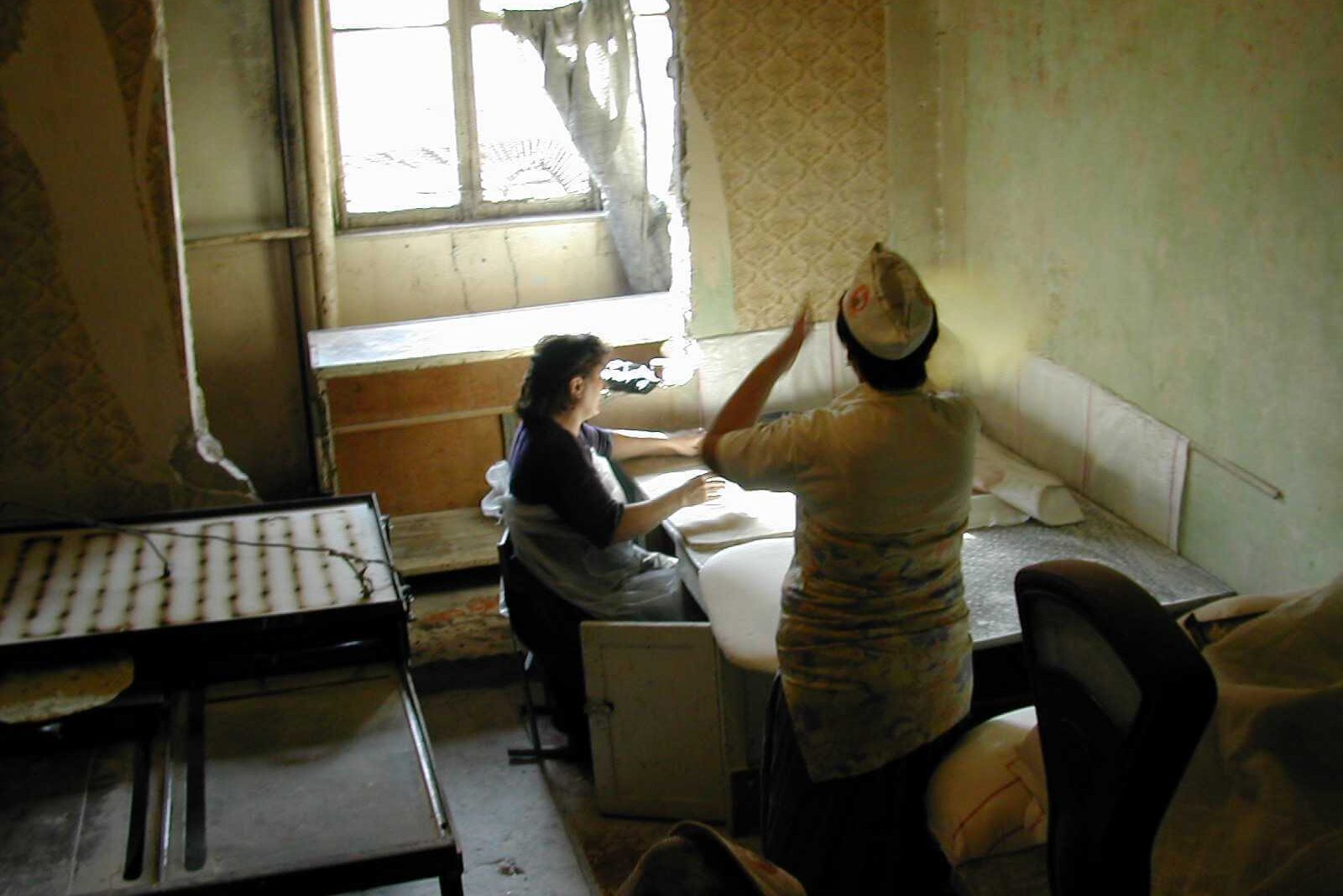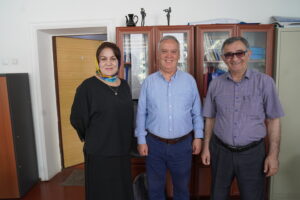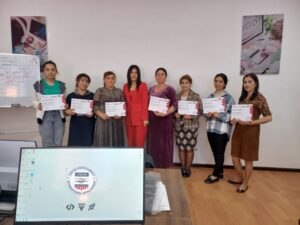With Gazelle Finance Fund, Eurasia Foundation Expands on Decades of Supporting Small Business in Eurasia

In the mid-1990s, small businesses had a difficult time in Armenia and Ukraine. Free markets were in their infancy, regulatory systems were chaotic, and lending practices were rudimentary. Many entrepreneurs had no access to credit and those who did often faced prohibitive terms: interest rates as high as 100 percent and repayment periods of less than 90 days. It was nearly impossible to get a normal, collateralized loan to make capital investments and expand a small enterprise.
SBLP Facts:
In operation: 1995-2004
Total disbursed: $17,278,886
Total loans made: 428
Jobs created: 3,047
Losses: less than 2% of disbursals
Eurasia Foundation spotted this need to reform lending practices and support job growth and in 1995 started an experimental program to foster entrepreneurship and small businesses in Armenia and Ukraine. Called the Small Business Lending Program (SBLP), EF wanted to kickstart small businesses while teaching local banks best practices in risk assessment and loan management. Under the able leadership of its director Bill Grant, and the extraordinary talents and commitment of the program’s local managers – Zakar Boyajyan in Armenia and Oksana Koval in Ukraine – SBLP became the most successful small business lending program ever undertaken in these countries by a foreign investor. And today, Zakar leads EF’s current small business investment initiative in Armenia – the Gazelle Finance Fund.
From 1995 to 2004, SBLP pioneered SME lending in Armenia and Ukraine, creating thousands of jobs and helping hundreds of small businesses, many of them family-owned, to expand. By creating a market for reasonably priced loans that nevertheless generated appealing rates of return, EF and SBLP steered Armenian and Ukrainian banks toward adopting lending practices that met the financial interests of banks while catalyzing sustained economic growth in the communities they serve.
Agnesa Knitwear
Small loans can have a great impact. A small knitwear manufacturer in Yerevan, Armenia, was an early recipient of SBLP financing.When Ashot Aghagulyan opened the company in 1991, just after Armenia’s independence, he faced a constant struggle to buy enough raw material to keep up with demand. By 1997 he was facing the closure of his business. So that year, SBLP gave Aghagulyan a loan of $35,000 and the turnaround in his business happened almost overnight.
Within six months, Aghagulyan expanded his line from sixteen to seventy-eight different types of clothing – all because SBLP provided sufficient capital to invest in different types of fabric and thread to accommodate the seasonal nature of knitwear. Within two years, the company had created sixteen new jobs, increased everyone’s salaries, and saw a 100 percent increase in sales.
Aghagulyan, like almost all SBLP borrowers, paid off his loan without any issues. SBLP gave him another loan in 2002 for $30,000, and again he repaid it within eighteen months.
The close partnership between Aghagulyan and SBLP was part of a sea change in lending practices in Armenia. Right after Armenia’s independence, banks often had contentious, opaque relationships with their business clients. SBLP introduced the idea of relationship banking, where lenders and borrowers openly align their interests, build trust and develop long-term, mutually profitable relationship.
At the same time, by emphasizing intensive interaction between SBLP specialists and local bank staff, the program introduced international-caliber small business credit analysis and collection methodology to partner banks. This unique partnership structure enabled SBLP to build local knowledge for credit analysis and loan management. The banks that partnered with SBLP to lend money also learned how to recover loan funds from defaulting borrowers – a major hurdle that was preventing more widespread small business lending. One of the obstacles facing recovery was the reluctance by banks to collect loan collateral at auction due to the difficulty associated with recovering their costs. SBLP helped the partner banks become more engaged, when necessary, in liquidation activities, resulting in lower losses in the short term and fewer defaults in the long term.
Another key factor in SBLP’s success was hiring and empowering local investment professionals to lead investment activities in-country. Eurasia Foundation matched experienced Western banking professionals with a local team, creating a mentor relationship that enabled SBLP to turn over day-to-day country operations to local staff early in the program’s development. In the case of Armenia, Eurasia Foundation identified a high performer in one of its partner banks, Zakar Boyajyan, and hired him as Assistant Country Director. Zakar rose to become the country director for SBLP and over a decade built a $10 million portfolio of 296 loans. He then parlayed that experience to become the Deputy Executive Director of one of Armenia’s top five commercial banks, Unibank.
In Ukraine, using the same approach, EF identified and hired a capable Ukrainian woman, Oksana Koval, to build a portfolio that grew to 132 loans totaling approximately $7 million over ten years. As a result, SBLP contributed toward the long-term growth of hundreds of enterprises and accelerated the emergence of profitable and sustainable small business SME lending in Ukraine.
Two of the banks with which EF partnered – today they are Anelik Bank in Armenia and Raiffeisen Bank Aval JSC in Ukraine – integrated SBLP’s credit analysis methodology into their lending. Anelik Bank decided to utilize the loan program credit analysis documentation throughout its entire customer base, making SBLP an engine of systemic financial reform. In Armenia, SBLP’s $10 million loan portfolio reached small businesses in every province and created more than 2,200 jobs.
Because of the effective credit analysis methodology EF implemented and the close partnership SBLP established with its borrowers, the repayment rate for these loans was unusually high for small lending programs in both countries: the charge-off rate (which is how much the lender believes will never be repaid) for Armenia was under 2 percent and for Ukraine was under 1 percent.
Such a low charge-off rate is unusual in a highly developed and stable market; in Ukraine, it is unprecedented. Businesses as diverse as car washes, travel agencies, printing and photograph services, light manufacturing and cable providers received loans of between $50,000 and $100,000 – and 99 percent of all the money lent was paid back in full. SBLP’s approximately $7 million in loans to Ukrainian businesses created more than 800 jobs, touching every province of the country.
Voske Varder Greenhouse
The long term success of SBLP had a powerful effect on local businesses. The Voske Varder greenhouse, which in Armenian means “Golden Roses,” was small: it covered less than a tenth of a hectare of growing space and its annual profit was around $10,000. Starting in 2001, SBLP and its partner banks loaned the owner, Haykaz Grigoryan, a series of escalating loans, from $10,000 to $120,000.The influx of cash SBLP steered to the greenhouse helped Haykaz buy out his two co-owners and dramatically expand revenue. Grigoryan expanded his growing space from 0.1 hectare to 5.6 hectares, and his annual profit grew from $10,000 in 2001 to $250,000 in 2011.
Fast forward to today, Haykaz is now seeking $800,000 in investment capital to expand production and purchase hydroponic technology, but local Armenian bank collateral requirements are still too onerous. According to Haykaz, “The banks in Armenia require 100 to 150 percent of collateral, yet they don’t value my greenhouse equipment and property at fair market value, preventing me from obtaining long-term financing. I would be interested in flexible financing that is more closely linked to my actual cashflows and cyclicality of my business as opposed to just collateral-based borrowing that grossly undervalues my business.”
Fortunately for Haykaz, Eurasia Foundation is launching a new initiative, the Gazelle Finance Fund, which will address a major gap in the marketplace by providing SMEs with growth capital via a debt/equity hybrid arrangement without requiring full collateral.
Client loyalty is the key to success in business. As Haykaz simply put, “I have been borrowing money from Zakar Boyajyan since I started my business and he was running SBLP. I trust Zakar and will do business with whatever institution that he represents.” Fortunately for Gazelle Finance, Zakar is now Chief Investment Officer for the program in Armenia.
While SBLP ceased its operations in 2005 – a decade of mentorship had cemented effective lending practices with local banks – its support to small businesses has had a lasting effect on the economy. Through SBLP, EF played an instrumental role in kickstarting the small business community in Ukraine and Armenia. Small businesses are often the driver of economic growth in any given community: the ecosystem of many small businesses interacting with each other tends to create more jobs and generate more economic activity than a single, large company dominating an economy. In the transitional economies of the Eurasia region, small businesses are especially important as the primary source of new jobs, replacing many positions that simply vanished along with the massive state-owned enterprises that had employed most people during the Soviet period.
Building on the success of SBLP, today Eurasia Foundation is addressing the unmet capital needs of entrepreneurs in this region by establishing the Gazelle Finance Fund. The Gazelle Finance Fund invests in small enterprises in Armenia, Georgia, Moldova and Kyrgyzstan with the aim of creating jobs, expanding tax revenues, and promoting responsible business practices. Gazelle Finance derives its name from the kind of enterprises the program targets. Gazelles are small businesses that have the potential rapidly to accelerate sales, generally at a rate of no less than 20 percent per year over several years. Gazelle Finance offers a combination of debt and equity financing in the range of $100,000 to $1,000,000 to promising small and medium enterprises that still face difficulties in accessing financing for capital investments. Clients of Gazelle Finance will also be eligible for targeted technical assistance to enhance the efficiency, transparency and compliance of their businesses.
Through programs like SBLP, for more than two decades EF has channeled resources to nourish the foundations of economic growth throughout the Eurasia region. And today, through Gazelle Finance, EF is building on its early investments in small businesses and is joining with entrepreneurs to provide the capital and expertise necessary to accelerate the growth of small businesses across the region.


